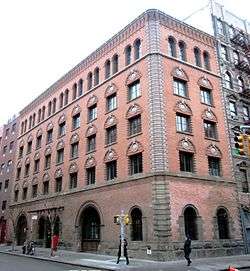Elizabeth Street (Manhattan)
Coordinates: 40°43′12″N 73°59′42″W / 40.720°N 73.995°W

Elizabeth Street is a street in Manhattan, New York City, which runs north-south parallel to and west of the Bowery. The street is a popular shopping strip in Manhattan's Nolita neighborhood.[1]
The southern part of Elizabeth Street was constructed in 1755 and it was extended north to Bleecker Street in 1816.[2]
In the late 19th and early 20th centuries, Elizabeth Street was filled with tenement buildings, largely populated by Italian immigrants.[3][4]
Notable buildings
Elizabeth Street has several buildings of note, including the New York Chinese School which caters to both Cantonese and Mandarin speakers; the Trust in God Baptist Church; and the New York City Police Department 5th Precinct.
11 Spring Street, a former stable and carriage house at the corner of Elizabeth Street, was built in 1888. It was once a noted magnet for graffiti artists, who covered the exterior of the building with their artwork. When the building was bought for conversion into condominiums, the developers, in collaboration with the Wooster Collective, mounted a show inside the building, inviting well-known graffitists – many of whom had work on the outside – to cover the entire five floors of the building's interior. The show opened in December 2006 for a few days, before work on the conversion began and the artwork was covered over or destroyed. Prior to its days as a canvas for graffiti, the stable had been the home of IBM employee John Simpson for 30 years. Simpson had filled it with Rube Goldberg-like mechanisms, and put burnt candles, surplus from the 1964 New York World's Fair, in the windows, giving the building its nickname at the time, the "Candle Building".[5][6]
In popular culture
In 2009, Laurie Fabiano published the novel Elizabeth Street, which presented a fictionalized account of a 1909 kidnapping in the Little Italy neighborhood.[7]
References
Notes
- ↑ Silverman, John (2008). Frommer's Portable New York City 2009. John Wiley & Sons. p. 164. ISBN 9780470289686.
- ↑ Presa, Donald G. (24 June 2003). NoHo East Historic District Designation Report (PDF). New York City Landmarks Preservation Committee. p. 8.
- ↑ Homberger, Eric (2004). Mrs Astor's New York: Money And Social Power In A Gilded Age. Yale University Press. pp. 29–30. ISBN 9780300105155.
- ↑ Dickie, John (2004). Cosa Nostra: A History Of The Sicilian Mafia. Palgrave Macmillan. pp. 163–164. ISBN 9781403966964.
- ↑ Kennedy, Randy. [http://www.nytimes.com/2006/12/14/arts/design/14graf.html?_r=0 "Last Hurrah for Street Art, as Canvas Goes Condo" The New York Times (December 14, 2006)
- ↑ "Spring Street" on New YUork City Songlines
- ↑ Roberts, Sam (9 July 2009). "When Albany Got Things Done". New York Times. Retrieved 30 November 2012.
External links
 Media related to Elizabeth Street (Manhattan) at Wikimedia Commons
Media related to Elizabeth Street (Manhattan) at Wikimedia Commons